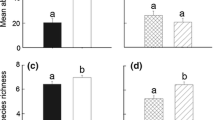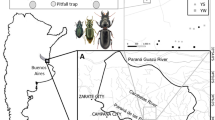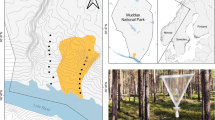Abstract
Research on changes in biodiversity due to the abandonment of forestry is important in understanding the role of reserves in conservation. The aim of this study was to investigate whether changes have occurred in species richness, abundance and composition of ground, longhorn and bark beetles due to habitat changes as a result of the cessation of forest management. We surveyed ten managed and ten abandoned forest plots in two watersheds located in the north-eastern Italian alpine region, which share a common history of use, climate regimes, stand structure and topography. Ground beetles, and longhorn and bark beetles were collected with pitfall and flight-intercept window traps, respectively, from May to mid-October 2010. The three beetle taxa responded differently to changes in habitat features and management cessation. Differences in individual species responses between the two watersheds may indicate a role of management abandonment through its impact on forest habitat structure. For instance, ground beetle species mainly responded negatively to soil moisture and positively to understorey vegetation cover. Unexpectedly, saproxylic species responded variably, and often negatively, to deadwood features in these forests, but did respond positively to the volume of standing Abies alba trees. The assemblages of carabids and bark beetles differed between the two watersheds. Our results confirmed that 50 years of forest management cessation resulted in changes in the biodiversity of beetles in alpine forests, likely due to their response to changes in habitat structure. Moreover, we expect that where the unplanned abandonment of forestry practices and habitat rewilding are undergoing, like in many marginal areas of Europe, similar habitat structure dynamics and beetle responses are likely to occur spontaneously.






Similar content being viewed by others
References
Abrahamsson M, Lindbladh M (2006) A comparison of saproxylic beetle occurrence between man-made high- and low-stumps of spruce (Picea abies). For Ecol Manag 226:230–237. doi:10.1016/j.foreco.2006.01.046
Andrich O (2005) Progetto Speciale Selvicoltura e Piano di Riordino Forestale. Parco Nazionale delle Dolomiti Bellunesi, Feltre
Bates D, Maechler M, Bolker B, Walker S (2014) Package ‘lme4’, Version 1.1-7. http://cran.r-project.org/web/packages/vegan/vegan.pdf
Bengtsson J, Nilsson SG, Franc A, Menozzi P (2000) Biodiversity, disturbances, ecosystem function and management of European forests. For Ecol Manag 132:39–50. doi:10.1016/S0378-1127(00)00378-9
Bouget C, Nusillard B, Pineau X, Ricou C (2012) Effect of deadwood position on saproxylic beetles in temperate forests and conservation interest of oak snags. Insect Conserv Divers 5:264–278. doi:10.1111/j.1752-4598.2011.00160.x
Bouget C, Larrieu L, Parmain G, Nusillard B (2013) In search of the best local habitat drivers for saproxylic beetle diversity in temperate deciduous forests. Biodivers Conserv 22:2111–2130
Bouget C, Parmain G, Gilg O, Noblecourt T, Nusillard B, Paillet Y, Pernot C, Larrieu L, Gosselin F (2014) Does a set aside conservation strategy help the restoration of old-growth forest attributes and recolonization by saproxylic beetles? Anim Conserv 17:342–353. doi:10.1111/acv.12101
Braun-Blanquet J (1932) Plant sociology. Mc-Graw Hill, New York
Brin A, Bouget C, Valladares L, Brustel H (2013) Are stumps important for conservation of saproxylic beetles in managed forests? – Insights from a comparison of assemblages on logs and stumps in oak-dominated forests and pine plantations. Insect Conserv Divers 6:255–264. doi:10.1111/j.1752-4598.2012.00209.x
Brunet J, Fritz Ö, Richnau G (2010) Biodiversity in European beech forests—a review with recommendations for sustainable forest management. Ecol Bull 53:77–94
Castellani C, Scrinzi G, Tabacchi G, Tosi V (1984) Inventario forestale nazionale italiano (I.F.N.I.), Tavole di cubatura a doppia entrata. Istituto Sperimentale per l’Assestamento Forestale e per l’Alpicoltura, Trento
Cobb TP, Langor DW, Spence JR (2007) Biodiversity and multiple disturbances: boreal forest ground beetle (Coleoptera: Carabidae) responses to wildfire, harvesting, and herbicide. Can J For Res 37:1310–1323. doi:10.1139/X06-310
Desender K, Maelfait J-P, Baert L (1991) Carabid beetles as ecological indicators in dune management (Coleoptera:Carabidae). Elytron 5(Suppl.):239–247
Ellenberg H (1988) Vegetation ecology of Central Europe. Cambridge University Press, Cambridge
Ellenberg H, Weber HE, Düll R, Wirth W, Werner W, Paulißen D (1991) Zeigerwerte von Pflanzen in Mitteleuropa. Scr Geobot 18:1–267
Fuller RJ, Oliver TH, Leather SR (2008) Forest management effects on carabid beetle communities in coniferous and broadleaved forests: implications for conservation. Insect Conserv Divers 1:242–252. doi:10.1111/j.1752-4598.2008.00032.x
Green P, Peterken GF (1997) Variation in the amount of dead wood in the woodlands of the Lower Wye Valley, UK in relation to the intensity of management. For Ecol Manag 98:229–238. doi:10.1016/S0378-1127(97)00106-0
Grove JS (2002) Saproxylic insect ecology and the sustainable management of forests. Annu Rev Ecol Syst 33:1–23
Hedgren PO (2007) Early arriving saproxylic beetles (Coleoptera) and parasitoids (Hymenoptera) in low and high stumps of Norway spruce. For Ecol Manag 241:155–161. doi:10.1016/j.foreco.2007.01.020
Hjältén J, Johansson T, Alinvi O, Danell K, Ball JP, Pettersson R, Gibb H, Hilszczański J (2007) The importance of substrate type, shading and scorching for the attractiveness of dead wood to saproxylic beetles. Basic Appl Ecol 8:364–376. doi:10.1016/j.baae.2006.08.003
Hjältén J, Stenbacka F, Andersson J (2010) Saproxylic beetle assemblages on low-stumps, high-stumps and logs: implications for environmental effects of stump harvest. For Ecol Manag 260:1149–1155. doi:10.1016/j.foreco.2010.07.003
Humphrey JW, Hawes C, Pearce AJ, Ferris-Khan R, Jukes MR (1999) Relationships between insect diversity and habitat complexity in plantation forests. For Ecol Manag 113:11–21. doi:10.1016/S0378-1127(98)00413-7
Jonsell M, Hansson J (2011) Logs and stumps in clearcuts support similar saproxylic beetle diversity: implications for bioenergy harvest. Silva Fenn 45:1053–1064. doi:10.14214/sf.86
Jonsell M, Schroeder M, Weslien J (2005) Saproxylic beetles in high stumps of spruce: fungal flora important for determining the species composition. Scand J For Res 20:54–62. doi:10.1080/02827580510008211
Kacprzyk M, Bednarz B (2014) The occurrence of bark beetles on cut Norway spruce branches left in managed stands relative to the foliage and bark area of the branch. J For Res. doi:10.1007/s10310-014-0449-y
Kotze DJ, Brandmayr P, Casale A, Dauffy-Richard E, Dekoninck W, Koivula MJ, Lovei GL, Mossakowski D, Noordijk J, Paarmann W, Pizzolotto R, Saska P, Schwerk A, Serrano J, Szyszko J, Taboada A, Turin H, Venn S, Vermeulen R, Zetto T (2011) Forty years of carabid beetle research in Europe—from taxonomy, biology, ecology and population studies to bioindication, habitat assessment and conservation. Zookeys 100:55–148. doi:10.3897/zookeys.100.1523
Kotze DJ, O’Hara RB, Lehvävirta S (2012) Dealing with varying detection probability, unequal sample sizes and clumped distributions in count data. PLoS ONE 7:e40923. doi:10.1371/journal.pone.0040923
Kula E, Kajfosz R, Polívka J (2011) Cambioxylophagous fauna developing on logging residues of blue spruce (Picea pungens Engelmann). J For Sci 57:24–33
Larrieu L, Cabanettes A, Delarue A (2012) Impact of silviculture on dead wood and on the distribution and frequency of tree microhabitats in montane beech-fir forests of the Pyrenees. Eur J For Res 131:773–786. doi:10.1007/s10342-011-0551-z
Lassauce A, Paillet Y, Jactel H, Bouget C (2011) Deadwood as a surrogate for forest biodiversity: meta-analysis of correlations between deadwood volume and species richness of saproxylic organisms. Ecol Indic 11:1027–1039. doi:10.1016/j.ecolind.2011.02.004
Lavorel S, Grigulis K, McIntyre S, Williams NSG, Garden D, Dorrough J, Berman S, Quétier F, Thébault A, Bonis A (2008) Assessing functional diversity in the field—methodology matters! Funct Ecol 22:134–147. doi:10.1111/j.1365-2435.2007.01339.x
Lemperiere G, Marage D (2010) The influence of forest management and habitat on insect communities associated with dead wood: a case study in forests of the southern French Alps. Insect Conserv Divers 3:236–245. doi:10.1111/j.1752-4598.2010.00094.x
Linsley EG (1959) Ecology of cerambycidae. Annu Rev Entomol 4:99–138. doi:10.1146/annurev.en.04.010159.000531
Magura T, Tothmeresz B, Elek Z (2003) Diversity and composition of carabids during a forestry cycle. Biodivers Conserv 12:73–85. doi:10.1023/A:1021289509500
Marshall PI, Davis G, LeMay WM (2000) Using line intersect sampling for coarse woody debris. Vancouver Forest Region, BC Ministry of Forests, Nanaimo
Martikainen P, Siitonen J, Kaila L, Punttila P (1996) Intensity of forest management and bark beetles in non-epidemic conditions: a comparison between Finnish and Russian Karelia. J Appl Entomol 120:257–264. doi:10.1111/j.1439-0418.1996.tb01603.x
Maser C, Anderson R, Cromack JK, Williams JT, Martin RE (1979) Dead and down woody material. In: Thomas JW (ed) Wildlife habitats in managed forests: the Blue Mountains of Oregon and Washington. Wildlife Management Institute, Washington, pp 78–95
Mayer H (1974) Wälder des Ostalpenraumes. Gustav Fisher Verlag, Stuttgart
Motta R, Berretti R, Lingua E, Piussi P (2006) Coarse woody debris, forest structure and regeneration in the Valbona Forest Reserve, Paneveggio, Italian Alps. For Ecol Manag 235:155–163. doi:10.1016/j.foreco.2006.08.007
Mullen K, O’Halloran J, Breen J, Giller P, Pithon J, Kelly T (2008) Distribution and composition of carabid beetle (Coleoptera, Carabidae) communities across the plantation forest cycle—implications for management. For Ecol Manag 256:624–632. doi:10.1016/j.foreco.2008.05.005
Müller J, Bußler H, Kneib T (2008) Saproxylic beetle assemblages related to silvicultural management intensity and stand structures in a beech forest in Southern Germany. J Insect Conserv 12:107–124. doi:10.1007/s10841-006-9065-2
Müller J, Noss RF, Bussler H, Brandl R (2010) Learning from a “benign neglect strategy” in a national park: response of saproxylic beetles to dead wood accumulation. Biol Conserv 143:2559–2569. doi:10.1016/j.biocon.2010.06.024
Niemelä J, Spence JR, Spence DH (1992) Habitat associations and seasonal activity of ground-beetles (Coleoptera, Carabidae) in central Alberta. Can Entomol 124:521–540. doi:10.4039/Ent124521-3
Niemelä J, Haila Y, Punttila P (1996) The importance of small-scale heterogeneity in boreal forests: variation in diversity in forest-floor invertebrates across the succession gradient. Ecography 19:352–368. doi:10.1111/j.1600-0587.1996.tb01264
Niemelä J, Koivula M, Kotze DJ (2007) The effects of forestry on carabid beetles (Coleoptera: Carabidae) in boreal forests. J Insect Conserv 11:5–18. doi:10.1007/s10841-006-9014-0
O’Hara RB, Kotze DJ (2010) Do not log-transform count data. Methods Ecol Evol 1:118–122. doi:10.1111/j.2041-210X.2010.00021.x
Ódor P, Standovár T (2001) Richness of bryophyte vegetation in near-natural and managed beech stands: the effects of management-induced differences in dead wood. Ecol Bull 49:219–229
Oksanen J, Blanchet FG, Kindt R, Legendre P, Minchin PR, O’Hara RB, Simpson GL, Solymos P, Stevens MHH, Wagner H (2013) Vegan: community ecology package. R package version 2.0-10. http://CRAN.R-project.org/package=vegan
Paillet Y, Bergès L, Hjältén J, Ódor P, Avon C, Bernhardt-Römermann M, Bijlsma RJ, De Bruyn L, Fuhr M, Grandin U, Kanka R, Lundin L, Luque S, Magura T, Matesanz S, Mészáros I, Sebastià MT, Schmidt W, Standovár T, Tóthmérész B, Uotila A, Valladares F, Vellak K, Virtanen R (2010) Biodiversity differences between managed and unmanaged forests: meta-analysis of species richness in Europe. Conserv Biol 24:101–112. doi:10.1111/j.1523-1739.2009.01399.x
Piussi P, Farrell EP (2000) Interactions between society and forest ecosystems: challenges for the near future. For Ecol Manag 132:21–28. doi:10.1016/S0378-1127(00)00376-5
R Development Core Team (2013) R: a language and environment for statistical computing. R Foundation for Statistical Computing, Vienna, Austria. http://www.R-project.org. Accessed 16 Dec 2013
Rudinsky JA (1962) Ecology of scolytidae. Annu Rev Entomol 7:327–348. doi:10.1146/annurev.en.07.010162.001551
Samways MJ (2007) Insect conservation: a synthetic management approach. Annu Rev Entomol 52:465–487. doi:10.1146/annurev.ento.52.110405.091317
Scarascia-Mugnozza G, Oswald H, Piussi P, Radoglou K (2000) Forests of the Mediterranean region: gaps in knowledge and research needs. For Ecol Manag 132:97–109. doi:10.1016/S0378-1127(00)00383-2
Schielzeth H (2010) Simple means to improve the interpretability of regression coefficients. Methods Ecol Evol 1:103–113. doi:10.1111/j.2041-210X.2010.00012.x
Schlyter F, Lundgren U (1993) Distribution of a bark beetle and its predator within and outside old-growth forest reserves: no increase of hazard near reserves. Scand J For Res 8:246–256. doi:10.1080/02827589309382774
Schmidt W (2005) Herb layer species as indicators of biodiversity of managed and unmanaged beech forests. For Snow Landsc Res 79:111–125
Siitonen J (2001) Forest management, coarse woody debris and saproxylic organisms: Fennoscandian boreal forests as an example. Ecol Bull 49:11–41
Similä M, Kouki J, Martikainen P (2003) Saproxylic beetles in managed and seminatural Scots pine forests: quality of dead wood matters. For Ecol Manag 174:365–381. doi:10.1016/S0378-1127(02)00061-0
Sitzia T, Trentanovi G (2011) Maggengo meadow patches enclosed by forests in the Italian Alps: evidence of landscape legacy on plant diversity. Biodivers Conserv 20:945–961. doi:10.1007/s10531-011-0006-3
Sitzia T, Semenzato P, Trentanovi G (2010) Natural reforestation is changing spatial patterns of rural mountain and hill landscapes: a global overview. For Ecol Manag 259:1354–1362. doi:10.1016/j.foreco.2010.01.048
Sitzia T, Trentanovi G, Dainese M, Gobbo G, Lingua E, Sommacal M (2012) Stand structure and plant species diversity in managed and abandoned silver fir mature woodlands. For Ecol Manag 270:232–238. doi:10.1016/j.foreco.2012.01.032
Sollins P (1982) Input and decay of coarse woody debris in coniferous stands in western Oregon and Washington. Can J For Res 12:18–28
Sroka K, Finch O-D (2006) Ground beetle diversity in ancient woodland remnants in north-western Germany (Coleoptera, Carabidae). J Insect Conserv 10:335–350. doi:10.1007/s10841-006-9008-y
Susmel L (1958) Piano di riordinamento della proprietà silvo-pastorale Costantini in Val Tovanella (1958–1967). Azienda di Stato per le Foreste Demaniali, Belluno
Taboada A, Kotze DJ, Tárrega R, Salgado JM (2006) Traditional forest management: do carabid beetles respond to human-created vegetation structures in an oak mosaic landscape? For Ecol Manag 237:436–449. doi:10.1016/j.foreco.2006.09.077
Taboada A, Kotze DJ, Tárrega R, Salgado JM (2008) Carabids of differently aged reforested pinewoods and a natural pine forest in a historically modified landscape. Basic Appl Ecol 9:161–171. doi:10.1016/j.baae.2007.01.004
Taboada A, Tarrega R, Calvo L, Marcos E, Marcos JA, Salgado JM (2010) Plant and carabid beetle species diversity in relation to forest type and structural heterogeneity. Eur J For Res 129:31–45. doi:10.1007/s10342-008-0245-3
Thiele HU (1977) Carabid beetles in their environments. Springer, Berlin
Toïgo M, Paillet Y, Noblecourt T, Soldati F, Gosselin F, Dauffy-Richard E (2013) Does forest management abandonment matter more than habitat characteristics for ground beetles? Biol Conserv 157:215–224. doi:10.1016/j.biocon.2012.07.025
Ulyshen MD, Hanula JL (2009) Habitat associations of saproxylic beetles in the southeastern United States: a comparison of forest types, tree species and wood postures. For Ecol Manag 257:653–664. doi:10.1016/j.foreco.2008.09.047
Väisänen R, Biström O, Heliövaara K (1993) Sub-cortical Coleoptera in dead pines and spruces: is primeval species composition maintained in managed forests? Biodivers Conserv 2:95–113. doi:10.1007/BF00056127
Van Wagner CE (1982) Practical aspects of the line intersect method. Petawawa National Forestry Institute, Canadian Forest Service, Chalk River
Varady-Szabo H, Buddle CM (2006) On the relationships between ground-dwelling spider (Araneae) assemblages and dead wood in a northern sugar maple forest. Biodivers Conserv 15:4119–4141. doi:10.1007/s10531-005-3369-5
Vuidot A, Paillet Y, Archaux F, Gosselin F (2011) Influence of tree characteristics and forest management on tree microhabitats. Biol Conserv 144:441–450. doi:10.1016/j.biocon.2010.09.030
Winter S, Möller GC (2008) Microhabitats in lowland beech forests as monitoring tool for nature conservation. For Ecol Manag 255:1251–1261. doi:10.1016/j.foreco.2007.10.029
Acknowledgments
We thank P. Brandmayr and A. Casale for providing useful information on the life history of the carabid beetles collected. This project was supported by the Italian Ministry of Agricultural, Food and Forestry Policies, State Forestry Corps, within the framework of the research agreement No. 767/2008 with the University of Padova (scientific coordinator: TS). The authors express their thanks to A. Andrighetti and F. Viola for their support in coordinating the work. Finally, we thank the two anonymous reviewers for their detailed comments that have improved this manuscript considerably.
Author information
Authors and Affiliations
Corresponding author
Additional information
Communicated by Jarmo Holopainen.
Electronic supplementary material
Below is the link to the electronic supplementary material.
Rights and permissions
About this article
Cite this article
Sitzia, T., Campagnaro, T., Gatti, E. et al. Wildlife conservation through forestry abandonment: responses of beetle communities to habitat change in the Eastern Alps. Eur J Forest Res 134, 511–524 (2015). https://doi.org/10.1007/s10342-015-0868-0
Received:
Revised:
Accepted:
Published:
Issue Date:
DOI: https://doi.org/10.1007/s10342-015-0868-0




